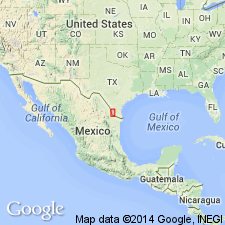
- Usage in publication:
-
- Salineno sandstone tongue
- Modifications:
-
- Areal extent
- AAPG geologic province:
-
- Gulf Coast basin
Summary:
Is basal sandstone member of Fayette formation in Starr Co, TX (Gulf Coast basin). "As this sandstone enters Starr County from Mexico it is about 40 feet thick and is recognizable for some distance north; however, as it is traced northward, like the Loma Blanca sandstone below, it gradually becomes extinct in a section of red and green bentonitic shales. *** The Salineno is a highly fossiliferous marine sandstone containing oysters and other shells. It is chiefly distinguished in the Roma area by an abundance of calcareous sandy concretions which are quite fossiliferous. The 'borings' of HALYMENITES are very plentiful throughout. The approximate equivalent of this sandstone with a nonmarine facies is found in the prominent west-facing cuesta on the Zapata-Hebbronville road, 1 1/4 mi northeast of Caliche Ranch, NW1/4 of Arroyo Clareno Quadrangle. Here there is found a 5-foot ash bed, resistant enough that it can be traced for a number of miles northward and is a valuable reference datum for locating the Yegua-Fayette contact." Overlies Los Arrieros shale member (new) of Yegua formation; underlies Resendez shale member (new) of Fayette. Assigned to the Eocene. Cross section from Laredo to Rio Grande City (fig 2). Locality map.
Source: GNU records (USGS DDS-6; Denver GNULEX).
For more information, please contact Nancy Stamm, Geologic Names Committee Secretary.
Asterisk (*) indicates published by U.S. Geological Survey authors.
"No current usage" (†) implies that a name has been abandoned or has fallen into disuse. Former usage and, if known, replacement name given in parentheses ( ).
Slash (/) indicates name conflicts with nomenclatural guidelines (CSN, 1933; ACSN, 1961, 1970; NACSN, 1983, 2005, 2021). May be explained within brackets ([ ]).

